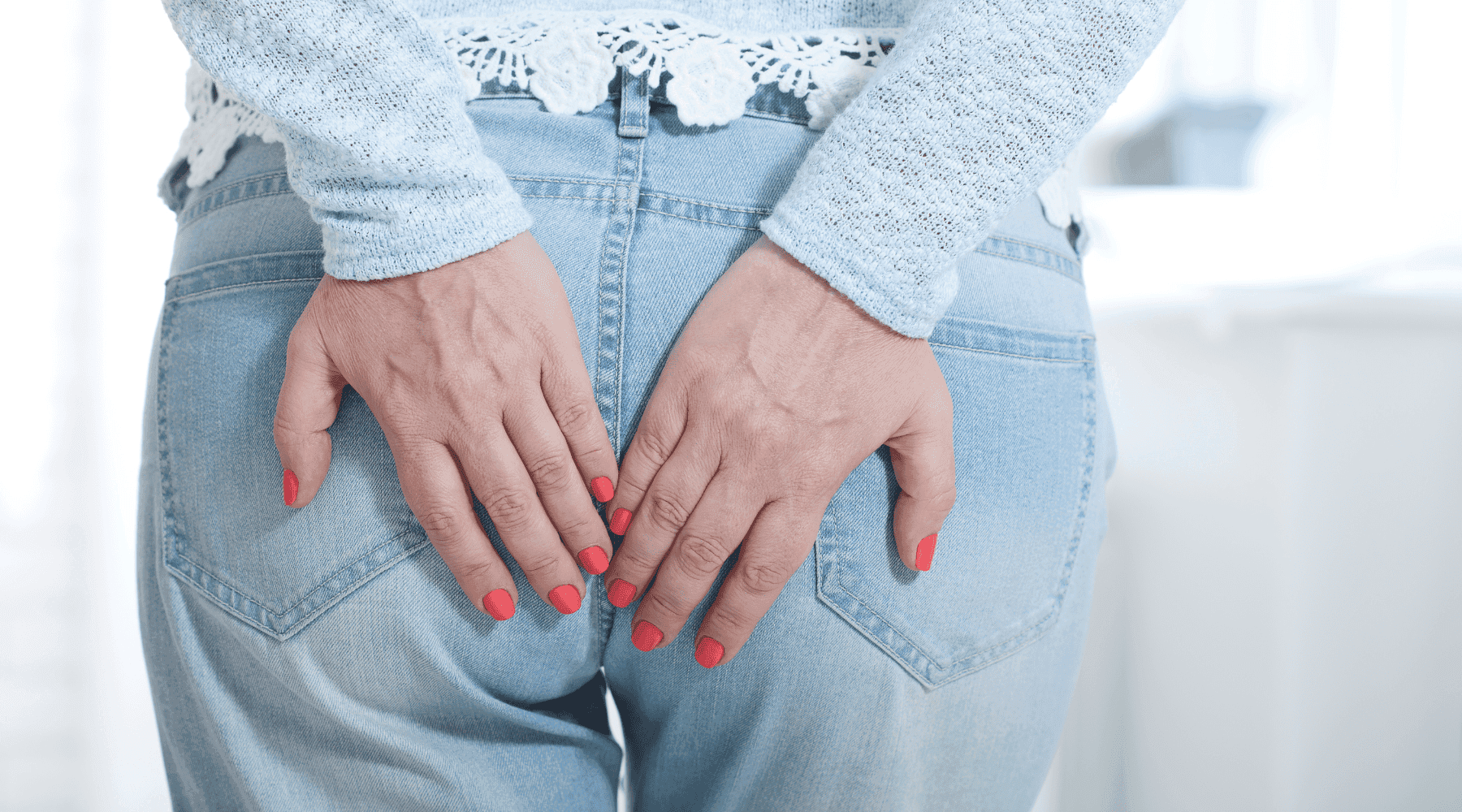Blood in Stool: Causes, Symptoms & When to See a Doctor

Dr. Vrundali Kannoth•5 minutes•10 Oct 2025
Blood in Stool: Causes, Symptoms & When to Worry
You're mid-scroll on your phone when your gut says, "Go now." Fast forward a few minutes; you glance down and freeze. Is that... blood in your stool? It's an unsettling sight, and suddenly, your mind races through every possibility, from "probably just piles" to "what if it's something serious?"
Most of us don't love talking about what happens in the bathroom, but the body has its own way of flagging when something isn't quite right. A streak of red might be harmless, or it could be an early colorectal cancer symptom. The problem is the signs and symptoms of blood in the stool often blur together.
So, how do you know when to relax, when to tweak your fibre intake, and when to take it seriously? In this guide, we break down what that blood could mean, the blood in stool symptoms you should be on the lookout for, and when to see a doctor.
First, what exactly are piles (Haemorrhoids)?
If you've ever had to brace yourself before a bowel movement or noticed a streak of red on the toilet paper, there's a good chance you've dealt with piles, the not-so-glamorous name for haemorrhoids.
These are swollen veins in the lower rectum or around the anus, and they're way more common than you think.
In fact,
It’s also important to know that piles can appear in two ways: internally, deeper inside the rectum, or externally, closer to the surface of the anus. They often show up thanks to straining, constipation, pregnancy, or even just sitting too long. While they can cause blood in the stool, itching, or a sore lump, they're usually not serious.
While piles are one of the common causes, other signs of blood in stool could point to something more serious. It's always worth checking if it's really just piles or something your body's trying to flag early.
Other common causes of blood in stool (and what they look like)
While haemorrhoids are a common cause, blood in stool causes go far beyond that. Bleeding can signal a range of issues, from minor irritation to conditions that need medical attention. Knowing the difference matters, especially when the symptoms overlap.
The type, colour, and timing of the bleeding can offer important clues. Here's how some of the most common reasons for blood in stool tend to show up:
Anal fissures
These are tiny but painful tears in the skin around the anus, usually caused by passing hard or large stools. The bleeding is bright red and often shows up on toilet paper.
Unlike piles, fissures come with a sharp, stinging pain during or after a bowel movement, sometimes lasting for hours. The discomfort often gets worse each time you try to go, making it a frustrating cycle.
Diverticular disease
Diverticula are small pouch-like bulges that form in the colon wall, especially in older adults. When they bleed (diverticular bleeding), it's often sudden, painless, and can be quite heavy.
Blood may appear as a large amount of red in the toilet, even if you don't feel unwell. There's typically no pain unless the diverticula become inflamed (diverticulitis), in which case cramping or fever may also occur.
Polyps
Polyps are small growths that form on the inner lining of the colon. Most are harmless, but some can slowly turn into colorectal cancer if left unchecked.
Bleeding from these is usually subtle, often so mild it's only picked up through stool tests. However, when the bleeding does become visible, it's typically darker in colour and mixed in with the stool rather than on the surface.
Polyps usually don't cause symptoms unless they grow large or multiply, which is why regular screenings are so important.
Colorectal cancer

Blood in stool caused by colorectal cancer tends to be darker, sometimes appearing maroon or tarry. It may even be mixed within the stool, making it harder to notice.
But symptoms don't just stop at the blood; they also include ongoing changes in bowel habits (like constipation, diarrhea, or narrower stools), unexplained weight loss, and constant fatigue.
The early signs can be vague and often mistaken for other diseases, such as IBS or diverticulitis, making regular checkups a must.
Inflammatory bowel disease (IBD)
This includes Crohn's disease and ulcerative colitis, both chronic conditions that cause inflammation of the digestive tract. Blood from IBD is often mixed with mucus and stool. You may also notice urgency, cramping, diarrhea, fatigue, and weight loss.
Unlike haemorrhoids or fissures, IBD symptoms are ongoing and flare in cycles, often needing long-term medical management.
Infections
Infections from bacteria, viruses, or parasites, like E. coli, Shigella, or amoebiasis, can trigger sudden episodes of bloody diarrhea. In these cases, blood often appears throughout the stool, not just on the surface, and comes with symptoms like fever, cramping, nausea, and an urgent need to use the bathroom.
Because symptoms can overlap with other conditions, stool tests are often needed to confirm the exact cause and guide treatment.
When to worry about blood in stool
Spotting the difference early can help you avoid unnecessary panic or catch important warning signs before they're missed.
Here's a quick comparison to help you spot the differences between haemorrhoids and other potential causes:
| Symptom | Haemorrhoids | Serious Conditions (e.g. Colorectal Cancer, IBD) |
|---|---|---|
| Type of Blood | Bright red appears after the stool | Darker red or maroon; may be mixed or within the stool |
| Pain | Usually painless (unless external) | May have cramping, abdominal pain, or soreness |
| Location of Blood | On toilet paper or in the bowl | Often, within the stool, it is harder to spot |
| Other Symptoms | Possible itching, mild discomfort | Fatigue, weight loss, change in bowel habits, mucus, or fever |
| Bowel Habit Changes | Unlikely | Common —constipation, diarrhea, urgency, or narrow stools |
| Recurring Bleeding | Can happen, often linked to strain | More concerning if persistent and unexplained |
| Need for Medical Attention | If frequent or painful | Always early detection is crucial |
What if you're still unsure?
Even after reviewing the symptoms, it's common to feel unsure. Many signs and symptoms of blood in stool overlap, and it's not always easy to self-diagnose without medical help.
Start by asking yourself:
- How often am I seeing blood?
- Is the blood bright red or darker in colour?
- Is it on the paper, in the bowl, or mixed with the stool?
- Have my bowel habits changed recently—more constipation, diarrhoea, or urgency?
- Am I feeling more tired than usual or losing weight without trying?
Keep a simple log of what you notice. Even a few notes can help your doctor spot patterns and rule things out faster. Whether it’s one of the milder blood in stool causes or something more serious, don’t ignore it. Remember, some signs of blood in stool could be subtle at first but grow in severity if untreated.
Track it, talk about it, take action
Noticing blood in stool can be unsettling, but it doesn't always mean something serious. In many cases, it's caused by piles or small tears that heal on their own. Still, it’s important to pay attention.
If the bleeding happens more than once, lasts longer than a few days, or shows up with symptoms like fatigue, weight loss, or changes in bowel habits, it could point to something more.
These can be early colorectal cancer symptoms, and catching them early makes a big difference.
FAQs on colorectal cancer symptoms
Any visible blood in stool should be taken seriously, even if it's just a small streak. While a few drops from haemorrhoids or a fissure may not be dangerous, repeated bleeding or larger amounts could signal something more serious, like colorectal cancer. It's best to get it checked if it happens more than once.
Piles (haemorrhoids) are usually diagnosed through a physical exam or, if internal, a quick rectal check by a doctor. If needed, further tests like an anoscopy may be done to rule out other causes of blood in the stool. Self-diagnosing can be tricky, so a clinical evaluation is always safer.
Yes, mild piles can go away on their own, especially with lifestyle changes like eating more fibre, staying hydrated, and avoiding straining. However, if blood in stool or discomfort continues, medical treatment may be needed to prevent flare-ups or complications.
Focus on a high-fibre diet to ease bowel movements and reduce strain; fruits, vegetables, whole grains, and legumes are great options. Stay hydrated and avoid processed, spicy, or constipating foods. If bleeding continues, a doctor should evaluate the cause before making major diet changes.
